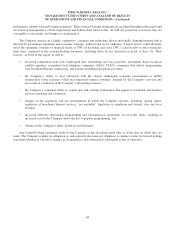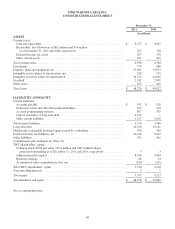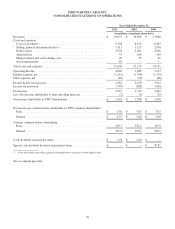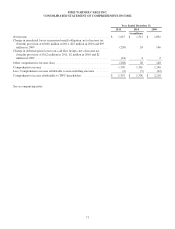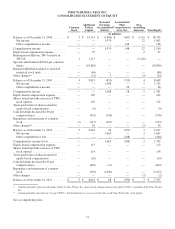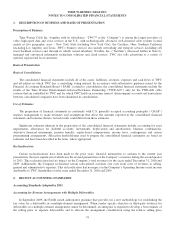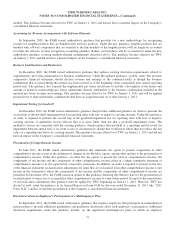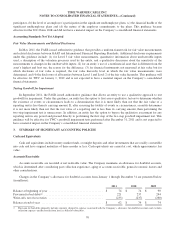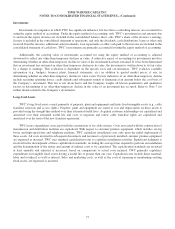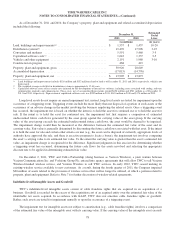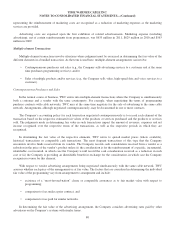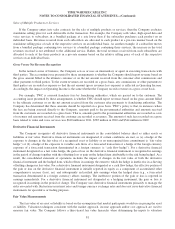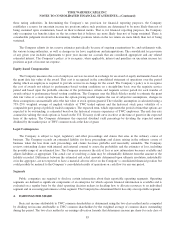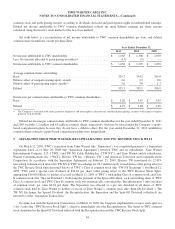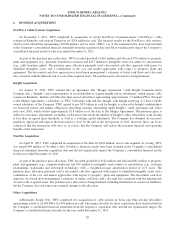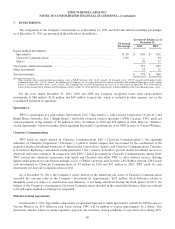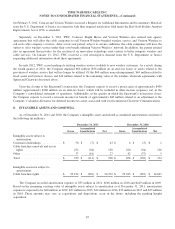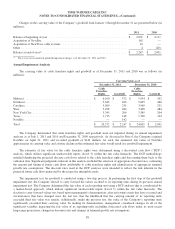Time Warner Cable 2011 Annual Report Download - page 86
Download and view the complete annual report
Please find page 86 of the 2011 Time Warner Cable annual report below. You can navigate through the pages in the report by either clicking on the pages listed below, or by using the keyword search tool below to find specific information within the annual report.
TIME WARNER CABLE INC.
NOTES TO CONSOLIDATED FINANCIAL STATEMENTS—(Continued)
As of December 31, 2011 and 2010, the Company’s property, plant and equipment and related accumulated depreciation
included the following:
December 31, Estimated
Useful
Lives2011 2010
(in millions) (in years)
Land, buildings and improvements(a) ................................. $ 1,557 $ 1,457 10-20
Distribution systems(b) ............................................ 19,470 17,996 3-25
Converters and modems .......................................... 5,591 5,460 3-5
Capitalized software costs(c) ........................................ 1,643 1,337 3-5
Vehicles and other equipment ...................................... 2,191 1,980 3-10
Construction in progress .......................................... 468 419
Property, plant and equipment, gross ................................ 30,920 28,649
Accumulated depreciation ......................................... (17,015) (14,776)
Property, plant and equipment, net .................................. $ 13,905 $ 13,873
(a) Land, buildings and improvements includes $158 million and $152 million related to land as of December 31, 2011 and 2010, respectively, which is not
depreciated.
(b) The weighted-average useful life for distribution systems is approximately 12.44 years.
(c) Capitalized software costs reflect certain costs incurred for the development of internal use software, including costs associated with coding, software
configuration, upgrades and enhancements. These costs, net of accumulated depreciation, totaled $658 million and $581 million as of December 31,
2011 and 2010, respectively. Depreciation of capitalized software costs was $209 million in 2011, $185 million in 2010 and $174 million in 2009.
Long-lived assets do not require an annual impairment test; instead, long-lived assets are tested for impairment upon the
occurrence of a triggering event. Triggering events include the more likely than not disposal of a portion of such assets or the
occurrence of an adverse change in the market involving the business employing the related assets. Once a triggering event
has occurred, the impairment test is based on whether the intent is to hold the asset for continued use or to hold the asset for
sale. If the intent is to hold the asset for continued use, the impairment test first requires a comparison of estimated
undiscounted future cash flows generated by the asset group against the carrying value of the asset group. If the carrying
value of the asset group exceeds the estimated undiscounted future cash flows, the asset would be deemed to be impaired.
The impairment charge would then be measured as the difference between the estimated fair value of the asset and its
carrying value. Fair value is generally determined by discounting the future cash flows associated with that asset. If the intent
is to hold the asset for sale and certain other criteria are met (e.g., the asset can be disposed of currently, appropriate levels of
authority have approved the sale, and there is an active program to locate a buyer), the impairment test involves comparing
the asset’s carrying value to its estimated fair value. To the extent the carrying value is greater than the asset’s estimated fair
value, an impairment charge is recognized for the difference. Significant judgments in this area involve determining whether
a triggering event has occurred, determining the future cash flows for the assets involved and selecting the appropriate
discount rate to be applied in determining estimated fair value.
On December 2, 2011, TWC and Cellco Partnership (doing business as Verizon Wireless), a joint venture between
Verizon Communications Inc. and Vodafone Group Plc, entered into agency agreements that will allow TWC to sell Verizon
Wireless-branded wireless service, and Verizon Wireless to sell TWC services. In early 2012, TWC ceased making its
existing wireless service available to new customers. As a result, during the fourth quarter of 2011, the Company impaired
$60 million of assets related to the provision of wireless service that will no longer be utilized, of which a portion related to
property, plant and equipment. Refer to Note 7 for further discussion of wireless-related agreements.
Indefinite-lived Intangible Assets and Goodwill
TWC’s indefinite-lived intangible assets consist of cable franchise rights that are acquired in an acquisition of a
business. Goodwill is recorded for the excess of the acquisition cost of an acquired entity over the estimated fair value of the
identifiable net assets acquired. In accordance with GAAP, TWC does not amortize cable franchise rights or goodwill.
Rather, such assets are tested for impairment annually or upon the occurrence of a triggering event.
The impairment test for intangible assets not subject to amortization (e.g., cable franchise rights) involves a comparison
of the estimated fair value of the intangible asset with its carrying value. If the carrying value of the intangible asset exceeds
78


